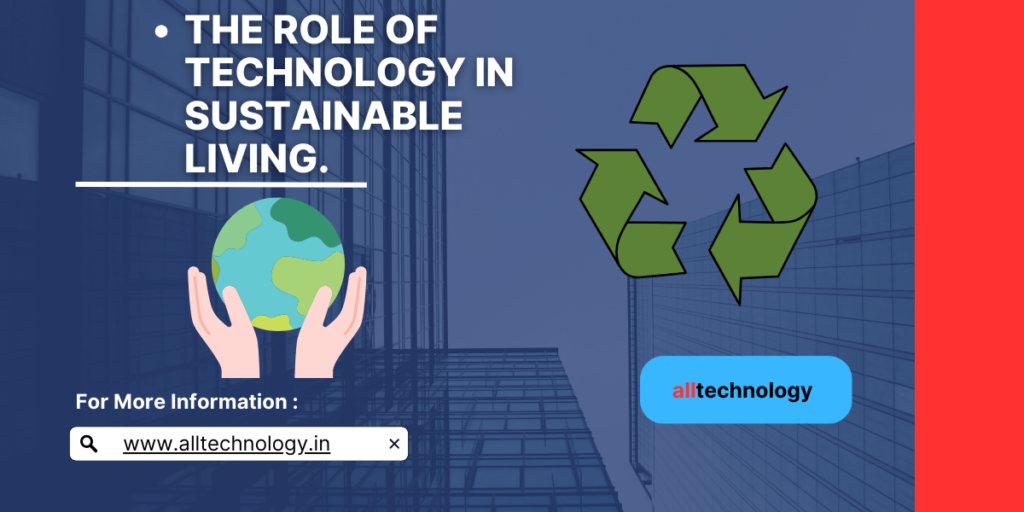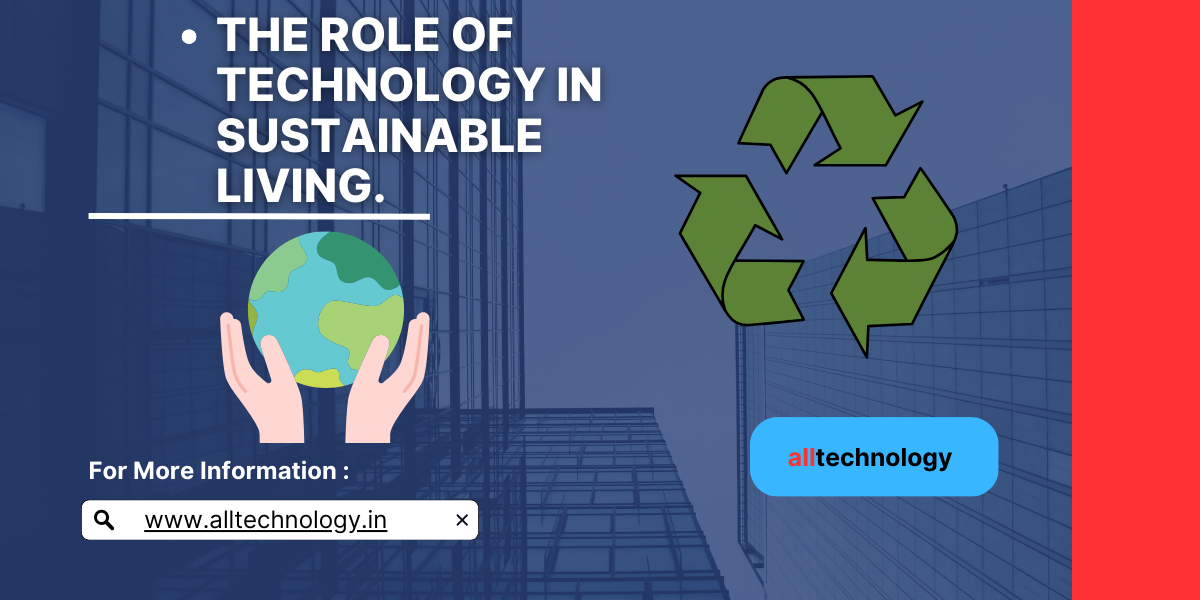Introduction
Hello Bloggers welcome alltechnology blog. In this blog you will learn The Role of Technology in Sustainable Living. In an era where the stakes of environmental degradation loom large, the quest for sustainable living has become paramount. Amid this pursuit, technology emerges as a beacon of hope, offering innovative solutions to some of the planet’s most pressing challenges. As we delve into the role of technology in fostering sustainable living, the intricate interplay of advanced systems and ecological mindfulness becomes evident, illustrating a path toward a greener future.

The Role of Technology in Sustainable Living
Technological Advancements in Renewable Energy
Renewable energy, a cornerstone of sustainable living, has seen transformative advancements thanks to technology. Wind turbines, solar panels, and bioenergy solutions are now more efficient and accessible than ever. Not only have solar cells improved in efficiency, but their production costs have plummeted, making green energy a viable option for a broader population. Wind energy, harnessed through sophisticated turbines, now generates significant portions of electricity in many regions, offering a cleaner alternative to fossil fuels. Additionally, the development of bioenergy, utilizing organic materials, contributes to reducing our carbon footprint, showcasing the diverse potential of renewable energy sources.
Smart Grids and Energy Management Systems
Modern technology has revolutionized energy distribution and management through the advent of smart grids. These grids use digital communications technology to detect and react to local changes in usage, ensuring optimal energy distribution. Energy management systems enable real-time monitoring and adjustments, reducing waste and increasing efficiency. Imagine a system where household appliances operate during off-peak hours to save on energy costs, or where electric vehicles charge during periods of low demand. This level of sophisticated energy management is made possible by integrating advanced technologies with everyday life.
Sustainable Agriculture and Food Production
Agriculture, an essential aspect of human survival, is being redefined by technology to ensure sustainability. Precision farming employs GPS and IoT devices to monitor crop health, soil conditions, and weather patterns. Drones and automated machinery enhance farming efficiency, reducing the need for chemical fertilizers and pesticides. Vertical farming and hydroponics, utilizing controlled environments, allow year-round cultivation with minimal land use and water consumption. These innovations not only boost productivity but also minimize environmental impact, paving the way for a more sustainable food future.
Water Conservation and Management Technologies
Water scarcity is a pressing global issue, and technology plays a pivotal role in addressing it. Advanced irrigation systems, such as drip and sprinkler systems, ensure water is used efficiently in agriculture. Water recycling and desalination technologies provide alternative sources of fresh water, reducing dependency on natural freshwater resources. Smart water management systems monitor usage and detect leaks in real time, conserving this vital resource. By integrating technology into water management practices, we can mitigate the effects of water scarcity and ensure a sustainable supply for future generations.
Sustainable Transportation Solutions
The transportation sector, a significant contributor to greenhouse gas emissions, is undergoing a transformation thanks to technological advancements. Electric vehicles (EVs) are becoming increasingly popular, supported by improvements in battery technology and charging infrastructure. Autonomous vehicles promise to enhance efficiency and reduce emissions through optimized driving patterns. Public transportation systems are also being upgraded with smart technologies, providing more efficient and eco-friendly travel options. These innovations are crucial in reducing the carbon footprint of transportation and promoting a greener future.
Green Building and Construction Technologies
Building and construction, industries traditionally associated with high environmental impact, are embracing sustainable practices through technology. Green building materials, such as recycled steel and sustainable timber, are gaining popularity. Energy-efficient designs, incorporating passive solar heating, natural ventilation, and advanced insulation, reduce energy consumption in buildings. Smart home systems monitor and control energy usage, ensuring optimal efficiency. By integrating sustainable technologies into construction practices, we can reduce the environmental footprint of our built environment.
Waste Management and Recycling Innovations
Effective waste management is essential for sustainable living, and technology is driving significant advancements in this area. Smart waste bins equipped with sensors can sort recyclables from non-recyclables, improving recycling rates. Advanced recycling technologies, such as chemical recycling, can break down plastics into their basic components for reuse. Waste-to-energy plants convert non-recyclable waste into energy, reducing landfill use and generating renewable energy. These innovations are crucial for creating a circular economy, where waste is minimized, and resources are continually reused.
Role of Information and Communication Technology (ICT)
Information and Communication Technology (ICT) is a key enabler of sustainable living. It facilitates the collection and analysis of data on energy usage, resource consumption, and environmental impact. Smart cities, utilizing ICT, can optimize traffic flow, reduce energy consumption, and improve waste management. Remote working, made possible by ICT, reduces the need for commuting, cutting down on transportation emissions. By leveraging ICT, we can make more informed decisions and implement more effective sustainability practices.
Technological Solutions for Climate Change Mitigation
Climate change is one of the most pressing challenges of our time, and technology offers powerful tools for mitigation. Carbon capture and storage (CCS) technologies can capture carbon dioxide emissions from industrial processes and store them underground. Renewable energy technologies, such as wind, solar, and bioenergy, reduce reliance on fossil fuels. Climate modeling and satellite monitoring provide crucial data for understanding and addressing climate change. By deploying these technological solutions, we can reduce greenhouse gas emissions and mitigate the impacts of climate change.
Future Prospects and Innovations
The future of sustainable living is bright, thanks to continuous technological innovation. Emerging technologies, such as artificial intelligence and blockchain, hold the potential to further enhance sustainability efforts. AI can optimize resource management and predict environmental impacts, while blockchain can ensure transparency and traceability in supply chains. As we look to the future, it is clear that technology will continue to play a crucial role in driving sustainable living and addressing the environmental challenges we face.
The Role of Technology in Sustainable Living
In our rapidly evolving world, technology is a double-edged sword. On one side, it fuels consumerism and depletes natural resources, yet on the other, it offers innovative solutions for a sustainable future. To truly appreciate the multifaceted impact of technology on sustainable living, we must delve into its complexities and the dynamic interplay of advancements shaping our ecological footprint.
Advancements in Renewable Energy
The quest for sustainable living hinges significantly on harnessing renewable energy. Solar panels, wind turbines, and hydroelectric systems have revolutionized our approach to energy consumption. These technologies are not mere alternatives; they are the keystones of a greener future. Solar power, for instance, has transcended its nascent stages of bulky, inefficient panels to sleek, high-efficiency systems capable of powering entire cities. Simultaneously, wind energy, captured by towering turbines, converts kinetic energy into electrical power with minimal environmental disruption. In stark contrast to fossil fuels, these sources offer an inexhaustible supply of energy, provided we continue to innovate and invest.
Smart Homes and Green Buildings
The integration of smart technology in our homes is another testament to how tech can drive sustainability. Smart thermostats, energy-efficient appliances, and automated lighting systems optimize energy use, reducing waste and cutting costs. Imagine a home that adjusts its temperature based on your daily routine, turning off lights when rooms are unoccupied, and even monitoring water usage to prevent wastage. Green buildings go a step further, incorporating sustainable materials and design principles that minimize environmental impact. These structures are not just energy-efficient but are also designed to enhance natural light, improve indoor air quality, and utilize rainwater harvesting systems. The result? A significant reduction in carbon footprint and a model for future residential and commercial buildings.
Sustainable Agriculture and Food Technology
Agriculture, the backbone of human civilization, faces immense pressure to meet the demands of a growing population. Here, technology plays a pivotal role in ensuring food security while promoting sustainability. Precision farming, for instance, leverages GPS technology, IoT devices, and data analytics to optimize crop yields, reduce water usage, and minimize chemical inputs. Vertical farming, another groundbreaking innovation, allows for the cultivation of crops in stacked layers, often in urban settings, reducing the need for land and cutting transportation emissions. Furthermore, advancements in biotechnology, such as genetically modified organisms (GMOs) and lab-grown meat, promise to revolutionize food production, offering solutions that are both resource-efficient and environmentally friendly.
Transportation and Electric Vehicles
The transportation sector is undergoing a seismic shift, with electric vehicles (EVs) at the forefront of this revolution. Traditional internal combustion engines, reliant on fossil fuels, are being replaced by electric motors powered by batteries. EVs produce zero tailpipe emissions, significantly reducing air pollution and greenhouse gas emissions. Moreover, the development of autonomous vehicles and ride-sharing platforms aims to optimize transportation efficiency, further decreasing the number of vehicles on the road. The proliferation of EV charging stations and advancements in battery technology, such as increased energy density and faster charging times, are critical to accelerating this transition.
Circular Economy and Waste Management
Finally, the concept of a circular economy, powered by technology, offers a paradigm shift from the traditional linear economy of “take, make, dispose” to a more sustainable model of “reduce, reuse, recycle.” Innovative waste management technologies, such as advanced recycling processes and waste-to-energy systems, are pivotal in this transition. For instance, pyrolysis and gasification technologies convert waste materials into energy, reducing landfill usage and lowering carbon emissions. Additionally, digital platforms facilitate the sharing economy, promoting the reuse of products and reducing overall consumption.
conclusion
the role of technology in sustainable living is both profound and complex. It is a driving force that can either exacerbate environmental challenges or provide innovative solutions to overcome them. By embracing technological advancements in renewable energy, smart homes, sustainable agriculture, transportation, and waste management, we can pave the way for a more sustainable and resilient future. As we navigate this intricate landscape, it is crucial to remain vigilant, ensuring that our technological progress aligns with the principles of sustainability.
FAQ
Question 1. What is the role of technology in sustainability?
Technology plays a crucial role in environmental conservation by providing innovative solutions to mitigate and reverse environmental degradation.
Question 2. How has technology caused sustainable living?
Being environment-friendly, reducing energy consumption, using new renewables energies, using LED lights, reducing waste through new and more efficient designing, manufacturing, computers, servers.
